The Gambia: A Great Place for Sailors
On their way to the Cape Verde Islands, Peter Hoefnagels and Inge van Berkel sailed their fossil-fuel-free vessel “The Ya” to The Gambia where they found an amazing country that is very open and welcoming to sailors.
Published 3 years ago

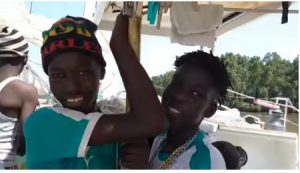
- Happy visitors to “The Ya”
We had a great time in The Gambia on our way to the Cape Verde Islands. What an amazing country! We always felt safe in every way: people, food, water, navigation. Only the fishing nets and taxis require careful navigation.
Arriving into The Gambia
We arrived at night and anchored at the ‘stop in time bank’. Do not anchor a bank closer to Banjul, because there are breaking waves.
In the morning we went to Banjul. We called in at VHF 16 for Port Control. On the fishers jetty, a man in a safety-vest indicated where to anchor: at ‘Half die’, just south of the wreck (washing). By dinghy we went to the small pontoon with some Senegalese fisher boats. On the pier, we met two ladies of Immigration in their mocca/yellow uniforms, who brought us to their office.
The shortcut they took led through the container terminal and we would have never found this ourselves. Quite an experience and one we hope never to have to repeat during the rainy season – we got vivid imaginations of the dirt roads covered in water, walking there with trucks, containers and people all over the place. But for now it was all good. We have outlined the Clearing in and Out process below.
Gambia is a great place to visit for sailors. The people are very friendly and we saw the amazing wildlife of Gambia with monkeys, hippos, birds etc. For health, as well as COVID requirements, take the normal precautions you have to take for health risks in the tropics such as washing your hands, take your vaccinations, malaria pills, mosquito repellents etc..
Sailing Up-River
Sometime in the 1980s, Peter, a German sailor, sailed his way through the creeks and bought a piece of land. He cut a way through the mangrove from the land to the creek. There, on a sandbank, he built his three floor Lamin Lodge. All constructed with the men from the Lamin community and with the wood from The Gambia. He made moorings for yachts and a dinghy dock.
At Lamin Lodge we were greatly helped by our guide Senna Touray (+220 7567907), who made sure we got everything we needed: fresh bread in the morning, fresh water, taxi rides, good provisioning, assistance in our visit to the hospital, thorough cleaning of the hull etc. etc. He is also an amazing cook (especially his ‘Domoda’!). You can ‘give from the heart’ but he also has a price-list and we think he offers great value for money. In Tendeba Camp, Malang (+220 3142547) he welcomed us, made sure we got the Gambian Benejin for lunch in the restaurant, took us to the local market by car for a small fee (300 Dalassi) and did the bargaining there.

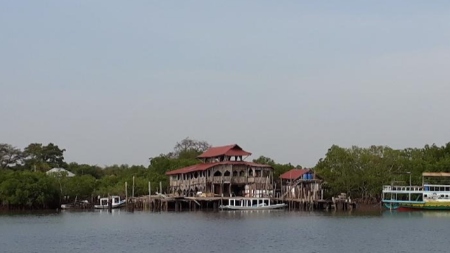
- Lamin Lodge is a great place to visit in Gambia.
Materials and Equipment to Contribute
The visits to the schools were especially impressive. At Bambally and Jarreng Tenda, we were approached by lots of children, asking for a football. We gave them watermelon and asked them to take us to their teachers. If you feel like contributing to the schools, we think that local seeds and A4-printing paper is going to be appreciated at Bambally school (along with the ever-popular footballs/pumps and small gardening equipment). At Jarreng Tenda school, again, footballs/pumps, exercise books etc. and here, if possible, storage aids such as cupboards and boxes would be welcome – teachers materials are now in a pile in the corner of the classroom. Most stuff you can buy in Banjul. If you need contact details please email us.

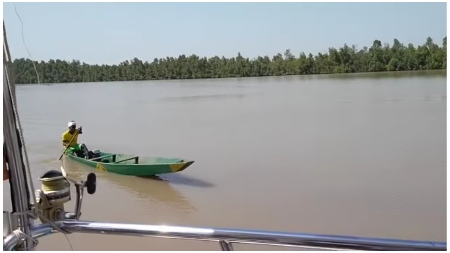
- Traveling up-river in Gambia.
Clearing in:
Immigration was a pleasant experience. Babou and his crew helped us through in four hours, including lessons in Mandinka and Wuluf, finding an ATM and a working SIM-card, taking photocopies of passports, arranging all necessary papers and no unforeseen ‘expenses’. We were happy we had some Spanish Turon (a sweet from Spain) with us to show our gratitude.
In steps:
- VHF Channel 16 Banjul Port Control: report your arrival.
- Pass the big fishers jetty and anchor near the wreck, moor the dinghy at the small jetty.
- Immigration: Goal: Stamp in passports with visa. They explain the procedures: EU-citizens get a 28-days VISA for free. After a month you have to pay. You can extend your visa in several places, the easiest perhaps being the airport for 1000 Dalassi p/p per month.
- Health (office next to Immigration): Goal: be allowed to return to Immigration again to continue procedures. We show COVID-vaccination certificates. We were asked for PCR-test-results even though they were not mandatory (we took them in Canary Islands just to be sure). We received no documents but were allowed to proceed.
- Immigration again – Now we got the stamps. We got the telephone number of officer Babou, in case we wanted to extend an extra month.
- Customs (3 locations, several visits): Goal: obtain the Boarding Officer’s report of the Department of Customs & Excise. If we remember correctly: The first group of officials fills in a form and ask if they can see the ship. When offered a ride in a small rowing dinghy this was perhaps not necessary. In the second location they copy this form and put a stamp. You need a safety vest to enter the location, which you can rent for 25 Dalassi next to the gate. In the third office they copy and file the form. We go back to office No. 1, to be sent back to office No. 2. Here the highest ranking officer signs and we can go back to office No. 1 where we get our copy of the form. We think several variations to this procedure are possible. Make sure that at the end you have one signed & stamped form with you, necessary to bring when you will clear out. If you want to do it quicker: call Mohammed before arrival and do the entire procedure with him. It might save you 1 1/2 hours. For us: we just enjoyed the ride.
- Port authority (blue building, 4th floor, reception might be difficult to pass, explain you come for clearing in at port authority, 4th floor) Goal: obtain The Gambia Ports Authority Boarding form for yachts. Pay 1,345.74 Dalassi and get a receipt. If you only have Euros, no problem, they will bring you down to a cashier lady four floors down, who will change it.
You get a map of The Gambia National Park and the rules that apply there. Pleasant atmosphere, we even got offered groundnuts.
Clearing out:
- Immigration Goal: Departure stamp in passport. Nice to meet Babou & crew again (especially Fatou who helped us all the way clearing in)
- Customs Goal: Forms C28 (r109): the ‘Entry outward of Vessel’ document. We got the form without any trouble at the first location. We paid 500 Dalassi. No receipt, so we are not sure if this was an official payment.
We thought we also had to pass by the Port authority. They appreciated it, ‘very thoughtful’, but it was not necessary. Just mention you are leaving by VHF 16 is enough.
Some Helpful Notes
The air draught of the Senegambia bridge 16.82m in Navionics, but we passed it easily with 17.5 meters. Friends with an 18 meter mast passed it on LW neap, and the skipper in top could just touch the underside of the bridge.
- The Senegambia Bridge and the power lines are not charted correctly on the Navionics chart. Correct location is 13 30.9936N, 015 34 3684W (in Navionics it is 0.7 NM more to the NE). Which makes it unsure whether the submarine cable next to the bridge is charted correctly. So do not anchor on the East side of the bridge.
- Power lines: Not in Navionics. Location approximately 13 20.1258N, 015 29.997W. Avoid the lowest part in the middle of the river; we passed on the south-bank side and it is higher than the Senegambia Bridge.

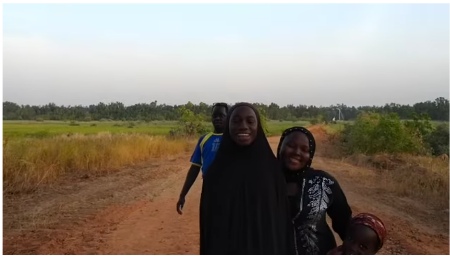
- Friendly people everywhere we went.
Our experiences:
We did several blogs on our visit to the The Gambia:
- https://fossilfreearoundtheworld.org/ya-at-lamin-lodge/
- https://fossilfreearoundtheworld.org/two-tales-on-west-african-batiks/
- https://fossilfreearoundtheworld.org/children-deep-down-in-gambia/
- https://fossilfreearoundtheworld.org/a-chain-of-changes-in-bambally-basic-school-cycle-gambia/
We also compiled a short vocabulary of some useful words and phrases with the notion that it is phonetic and that Mandinka also has two ‘dialects’ which might add to the confusion. Nevertheless, all attempts are greatly appreciated and the bonus-word is Tapalapa – fresh bread rolls. Baked twice a day, for 7 cents anywhere in the Gambia.
Inge van Berkel and Peter Hoefnagels
SY The Ya
………………………………………………………………………………………………………………………………………
About the Authors

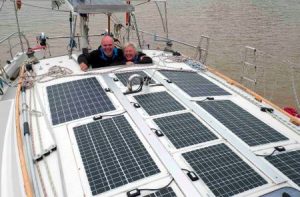
- Inge and Peter in the cockpit of “The Ya”
Peter Hoefnagels and Inge van Berkel are sailing around the world without using fossil fuels. No diesel, no gas, no petrol. On-board life is energy neutral and very comfortable. Says Inge: Sustainable cruising means sailing globally, living locally. We buy, eat, live and act where we anchor. With the locals we exchange information and methods about sustainability and living self supporting. Whatever we learn from them, we share with you on our blog. In exchange, we deliver a clean wave in all corners of the globe.
……………………………………………………………………………………………………………………………………
Related Links:
- Gambia: Skirting the Covid Chaos (Feb, 2021)
- Ya: The Yacht That Sailed the World Fossil Fuel Free
- Fossil Free Around the World Website
- Electric Boat: What are the options for going electric? (Yachting Monthly July 2020)
…………………………………………………………………………………………………………………………………..
The opinions expressed in this article are the author’s own and do not reflect the view of Noonsite.com or World Cruising Club.
Related to following destinations: Banjul, Cape Verdes, Gambia




